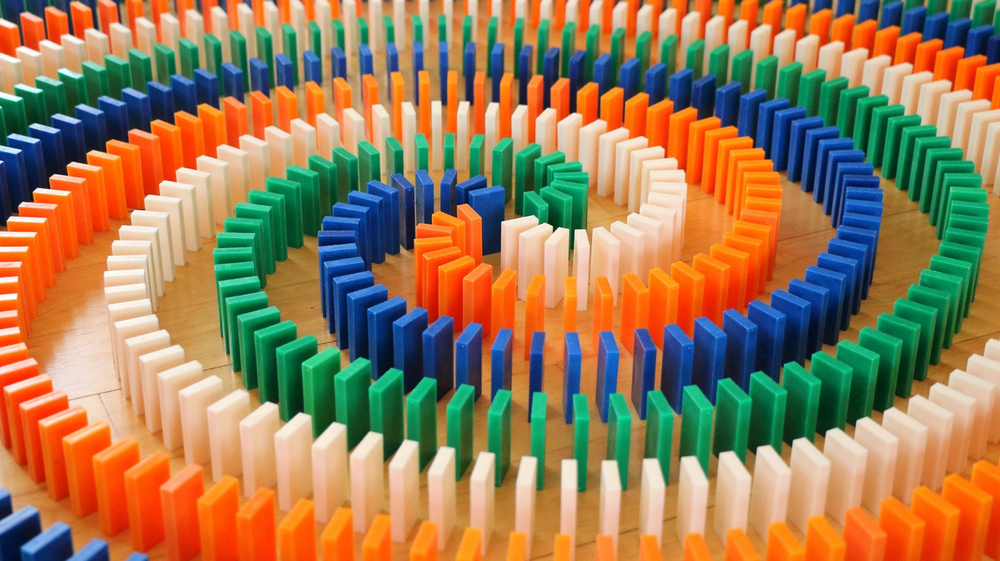Friction Is Key in Domino Physics
Despite the apparent simplicity of toppling dominoes, physicists still don’t have a complete model of the phenomenon. But new numerical simulations get a step closer by untangling the influence of two types of friction—one between neighboring dominoes and the other between each domino and the surface beneath it [1]. The researchers found that, in some cases, these two friction coefficients play competing roles in determining the speed of the domino cascade. They also found that one of the coefficients behaves similar to friction in granular systems such as piles of sand or pharmaceutical pills, suggesting that the domino simulations may provide insights into other situations where friction is important.
A YouTube video by engineer Destin Sandlin (on his channel Smarter Every Day) inspired David Cantor of Montreal Polytechnic and Kajetan Wojtacki of the Institute of Fundamental Technological Research of the Polish Academy of Sciences in Warsaw to study dominoes. Sandlin recorded a series of domino toppling experiments with a high-speed camera and quickly discovered just how complex the problem is. He determined that the wave of falling dominoes moves slightly faster on felt than on a slippery hardwood floor. He also saw surprising anomalies, such as cases where the train of toppling dominoes would abruptly stop.
Sandlin observed that a slippery surface can cause a domino to slide backward while falling forward and thus hit the next domino somewhat lower down when compared with dominoes on high-friction felt. But experimental limitations prevented him from fully explaining the effects of friction on the wave speed. Researchers have previously performed experiments and simulations and developed theories for domino toppling, but no one has systematically studied how domino-surface friction, domino-domino friction, and domino spacing affect the wave speed. Cantor and Wojtacki performed simulations that would fully control these parameters in hopes of better explaining observations.
From their comprehensive campaign of 1210 simulations that included 200 dominoes in each, Cantor and Wojtacki found that, when the spacing is half of the domino thickness, domino-surface friction and domino-domino friction play competing roles: Increasing the friction between dominoes causes the wave front to slow down because friction absorbs some energy from the wave of motion. Increasing friction with the surface beneath speeds up the wave because it reduces domino backsliding, allowing each one to strike its neighbor higher up, where the impact is more effective, the researchers believe.
However, when the dominoes were more widely spaced—the team observed spacings up to 5 times the domino thickness—the surface friction had little effect on the wave speed. Cantor and Wojtacki think that at higher spacings, the dominoes fall farther and hence acquire more kinetic energy before hitting their neighbors. When impacted more forcefully, it turns out that a domino is less likely to backslide, regardless of the surface friction.
Cantor and Wojtacki also found that for spacings wider than 3 times the domino thickness, the wave was unstable and could spontaneously stop if the surface was relatively slippery and the domino-domino friction was high. In this case, the backsliding could cause the wave to cease because of the wide spacing—a domino could slide back so far that it could topple but never reach its neighbor.
The pair also observed that if they increased the domino-domino coefficient of friction beyond 0.4, the wave front speed didn’t change much. Cantor and Wojtacki think that the higher the friction, the less the dominoes slide against one another, so, eventually, the amount of friction doesn’t matter. The researchers write that a similar “saturation” effect at a value of about 0.4 has been seen in studies of the effect of friction on the steepness of the sides of a stable pile of sand or other granular material. So they speculate that a universal phenomenon may be involved.
Caishan Liu of Peking University says that domino-like behavior is ubiquitous and is seen in phenomena ranging from nanofriction and molecular collisions to earthquakes and economic activities. “Characterizing the relationship between macroscopic motion and microscopic mechanisms of such systems has been one of the fundamental scientific issues,” he says.
Liu thinks Cantor and Wojtacki’s work is “important for understanding the relationship between the global behavior of the domino system and the physical parameters,” but he says the problem is far from solved. “There is still a lot of work to be done to reveal the physical mechanisms."
Correction (21 June 2022): This story has been updated with the correct name of Wojtacki’s institution.
–Katie McCormick
Katie McCormick is a freelance science writer based in Sacramento, California.
References
- D. Cantor and K. Wojtacki, “Effects of friction and spacing on the collaborative behavior of domino toppling,” Phys. Rev. Applied 17, 064021 (2022).




